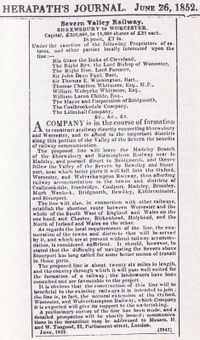The Severn Valley Railway Company (19th Century)
Following the failure of the Shropshire Union Railways and Canal Company to proceed with their proposed railway in the Severn Valley, a number of interested parties engaged Robert Nicholson to carry out another survey in 1849.[1] This led to the establishment of the Severn Valley Railway Company ("the Company") which was formed in 1852, although not officially incorporated until 1853. It was responsible for building the Railway from 1858 through to opening in February 1862. Although the Railway was operated from opening by the West Midland Railway ("WMR") and subsequently by the GWRGreat Western Railway from August 1863, the Company retained a separate identity until it was fully amalgamated into the GWRGreat Western Railway on 1 July 1872.
Contents
1852
The plans for the SU's proposed railway, drawn up by Robert Stephenson in 1846, had started from a station in Worcester. By 1852 the OWWOxford Worcester and Wolverhampton Railway had been planned, so Nicholson proposed a shorter route starting from a connection with the OWWOxford Worcester and Wolverhampton Railway south of Hartlebury. To avoid the opposition of Thomas Whitmore, owner of the Apley Park Estate, Nicholson’s route crossed the Severn at Quatford, south of Bridgnorth and proceeded through the Low Town. It then passed east of the Apley estate before joining the Madeley Branch of the Shrewsbury and Birmingham Railway.
On 26 June 1852, an article appeared in Herepath's Journal announcing the proposed formation of the company to construct the Severn Valley Railway. The advertisement confirmed that a preliminary survey had been carried out and listed Whitmore among the sponsors.[2]
The first meeting of the Board took place on 25 August 1852, at which it was proposed to form a company to be called the Severn Valley Railway Company. Seven Directors were appointed, of whom the Chairman Jonathan Thorp and two others were also directors of the OWWOxford Worcester and Wolverhampton Railway. Robert Nicholson was named Engineer. An Act of Parliament would be required to incorporate the Company and authorise the construction of the line.[3]
At a second meeting on 6 September a decision was taken to hold public meetings at Ironbridge, Bewdley and Bridgnorth to gauge support. These were arranged for 7, 8 and 9 October. A notice of the meetings in the Worcestershire Chronicle and Provincial Railway Gazette expressed hope that the new Severn Valley Railway "...stands on a more secure foundation than the last of that name, projected in 1847, the bills for advertising which are we believe unpaid to this day and likely to remain so."[2]
The public meetings were in favour of extending the line to Shrewsbury rather than Madeley and on 13 October 1852 the Board resolved to do so. The new route would mean passing close to Apley Hall, which led Whitmore to oppose the revised plan and instead support a rival and ultimately unsuccessful proposal, the Shrewsbury, Ironbridge and Bridgnorth Railway. The notice of intended application for an Act to incorporate the Severn Valley Railway Company and authorise the construction of the line was published on 2 November 1852[2].
1853
The SVRSevern Valley Railway Bill was presented in Parliament on 11 February 1853. It initially met with opposition from the 'Shrewsbury companies' which caused some delay and additional expense. The Bill proposed terminating the line at a point in Shrewsbury from which a connection to one of the existing lines could be authorised by subsequent legislation.[4]
In June, a meeting at Kidderminster chaired by the Mayor strongly supported moving the connection with the OWWOxford Worcester and Wolverhampton Railway from Hartlebury to Kidderminster. However this was opposed by a subsequent meeting at Stourport and the suggestion was not taken up.[4]
After consideration in Committee, the Bill was passed in the House of Commons in July and presented to the House of Lords on 9 August. It received Royal Assent on 20 August 1853. The Act incorporated the Company and authorised it to raise £600,000 in shares and to borrow up to an additional £200,000. Powers were given to construct a railway from a junction with the OWWOxford Worcester and Wolverhampton Railway 5½ furlongs south of Hartlebury and terminating in Shrewsbury, with a branch from Benthall Edge to Madeley. Opposite Apley Hall, the line was to pass through tunnels approximately 680 yards in length.[5] The original estimate for construction of the line was £600,000, being £110,000 for land plus £490,000 for works.[6]
On 1 September 1853 at the first Board meeting following incorporation, Robert Nicholson’s appointment as Engineer was confirmed at a salary of £1,000 p.a. The following month a deviation at Shrewsbury was proposed, shortening the line to join the Shrewsbury & Hereford Railway south of Shrewsbury. Nicholson prepared a plan and section and a Bill of Parliament was prepared for the 1854 session[7].
See also
References
- ↑ Marshall (1989) p. 20.
- ↑ 2.0 2.1 2.2 Marshall (1989), pp 20-24
- ↑ Nabarro (1971) p. 15.
- ↑ 4.0 4.1 Marshall (1998), pp. 25-27
- ↑ Marshall (1989), p.28
- ↑ Handbook to the Severn Valley Railway, by J. Randall 1863
- ↑ Marshall (1989), p.29
